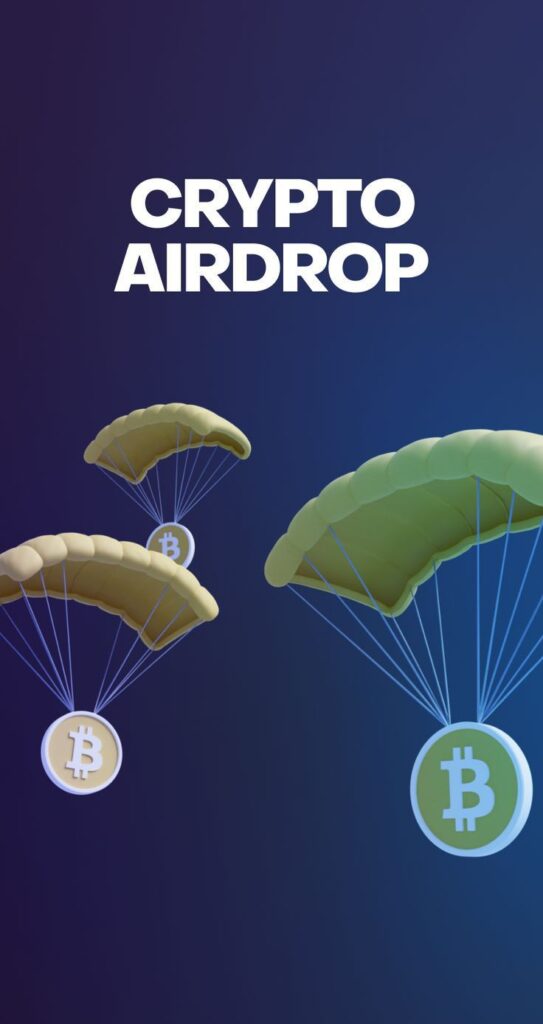what is airdrop
A crypto airdrop is a marketing strategy used by blockchain projects to distribute free tokens or cryptocurrencies to a wide audience. Airdrops are typically done to promote a new project, create awareness, or reward early supporters and loyal community members.
There are different types of airdrops:
Standard Airdrops: Free tokens are distributed to users who sign up for the airdrop event.
Holder Airdrops: Tokens are distributed to individuals who already hold a specific cryptocurrency.
Exclusive Airdrops: Tokens are given to users who have been active participants in the project’s ecosystem.
Bounty Airdrops: Users receive tokens in exchange for completing small tasks like sharing content on social media or referring friends.
Airdrops help drive interest in a new cryptocurrency by distributing tokens widely and often before the token is listed on exchanges.

where we use ?
Airdrops in the cryptocurrency world serve various purposes, mainly revolving around the promotion and distribution of new tokens. Here’s a detailed breakdown of where and how airdrops are commonly used: Marketing and Promotion
One of the most common uses of airdrops is as a marketing tool to create buzz around a new cryptocurrency project. By giving away free tokens, blockchain startups can generate interest and excitement in the crypto community. This process increases awareness of their project and helps attract potential investors, developers, and users. Airdrops are often announced on social media platforms, cryptocurrency forums, and specialized airdrop websites to maximize visibility.
Rewarding Early Supporters
Airdrops are frequently used to reward early adopters and loyal community members. For example, users who supported a project during its early stages by holding its token or participating in its ecosystem may be eligible to receive additional free tokens. This encourages long-term loyalty and creates a sense of community ownership in the project, as holders are incentivized to continue supporting the platform’s development.
Decentralized Governance
In some blockchain ecosystems, tokens distributed via airdrops grant holders voting rights in the project’s governance. This allows the community to have a say in the decision-making process for the future development and direction of the project. By distributing tokens to a wide audience, the project ensures that governance remains decentralized, avoiding concentration of power among a few large holders.
Increasing Network Participation
Airdrops can encourage users to actively engage with a blockchain project’s ecosystem. For example, an airdrop may reward users who perform specific tasks like trading on a decentralized exchange, staking tokens, or using a DeFi protocol. This increases network activity and user adoption, which can help the project grow its user base and improve its overall utility.
Bootstrapping Liquidity
Some projects use airdrops to distribute tokens to users who provide liquidity to decentralized finance (DeFi) platforms. These tokens can then be traded or staked, which helps boost the project’s liquidity and market presence. This approach is particularly popular in DeFi ecosystems, where liquidity is essential for the smooth operation of decentralized exchanges and other financial applications.
In summary, airdrops are an essential tool in the cryptocurrency world for generating awareness, rewarding loyal users, fostering decentralized governance, increasing participation, and enhancing liquidity.

Token Utility
This refers to the purpose and function of the airdropped token within the project’s ecosystem. Understanding the token’s utility is crucial because it determines its long-term value. Tokens can serve a variety of purposes, such as:
Governance: Token holders can vote on project decisions or protocol updates, ensuring decentralized control.
Staking: Users can lock up tokens to secure the network and earn rewards.
In-App Purchases: In some ecosystems, tokens are used to buy services or products within the platform, such as NFT purchases, subscriptions, or access to premium content. Knowing the utility helps users gauge how valuable and relevant the token might be in the future.

Airdrop Eligibility
Eligibility refers to the criteria that determine who can receive the airdrop. Each project has different requirements, including:
Holding Specific Tokens: Users may need to hold a certain cryptocurrency, such as ETH or SOL, in their wallets at a particular snapshot time.
Network Participation: Sometimes, users must have interacted with a project by using its services, staking, or providing liquidity.
Task Completion: For bounty airdrops, users may be asked to follow social media channels, join the project’s community, or refer new users. Clear eligibility criteria help users understand if they qualify for an airdrop and what actions they need to take.

Token Value Potential
This is the projected future growth of the token in terms of market value and utility. Several factors influence the token’s potential, such as:
Market Demand: How likely people are to want or need the token.
Scarcity: Limited token supply often increases value, especially if demand rises.
Use Case: Tokens with real-world applications or strong use cases tend to have higher value potential. By evaluating the token’s potential, users can gauge whether the airdrop could result in a valuable asset over time.

Project Backing
The strength of the team, partnerships, and venture capital involved can significantly impact the project’s success. Key aspects include:
Team Expertise: The reputation and experience of the founders and developers matter, as a strong team is more likely to deliver on promises.
Partnerships: Collaborations with established blockchain companies or traditional industry players can boost the credibility and resources of a project.
Venture Capital Support: Projects with funding from reputable investors tend to have the financial stability to grow and execute long-term plans. Backing helps determine the likelihood of a project succeeding and fulfilling its vision.
Community Engagement
A strong, engaged community can be a significant indicator of a project’s long-term health. Elements of community engagement include:
Social Media Activity: Active communities on Twitter, Telegram, Reddit, or Discord can increase the visibility and interest in the project.
User Participation: Regular participation in polls, discussions, or airdrop events indicates a healthy ecosystem.
Support for Governance: Communities that contribute to decentralized governance are more likely to stay invested in the project’s future. The larger and more active a community, the greater the chance of the project achieving sustainable growth.

Airdrop Distribution
DateThe date and method of distribution are critical for participants to know when and how they will receive their tokens. Key considerations include:
- Snapshot Timing: Some airdrops are based on wallet snapshots taken at specific times, so users must hold the required tokens before this date.
- Distribution Method: Tokens may be sent directly to wallets, or users might have to claim them manually through a platform.
- Vesting Period: In some cases, tokens are released gradually over time rather than all at once. Knowing the distribution details helps participants prepare and plan for how to manage their newly acquired tokens.
Each of these factors plays an important role in evaluating the potential value of airdrops and helps users make informed decisions about participating in them

